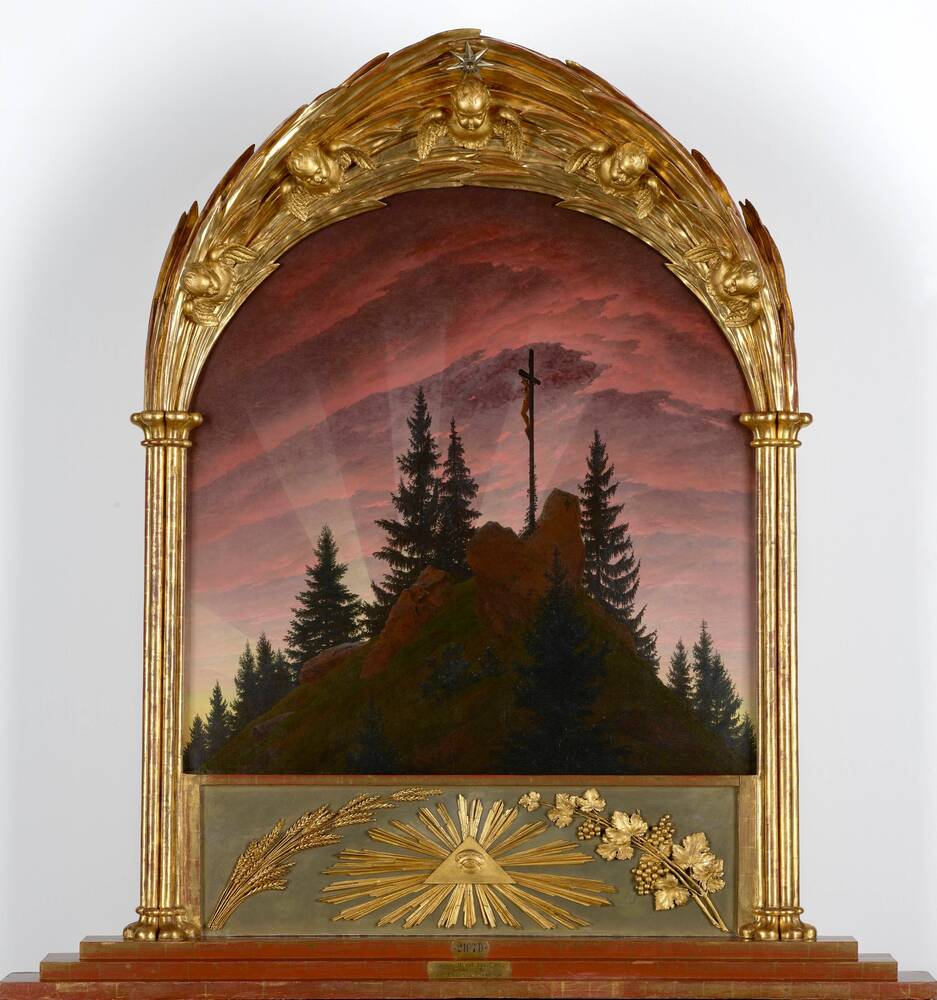If you have ever gone hillwalking, you may be familiar with that uplifting moment when the summit suddenly comes into view – and also have experienced a feeling of awe in the face of the grandeur of nature. For Caspar David Friedrich, born in Greifswald in 1774, such feelings were extremely important. He no longer sought and found God solely in church rituals, but also in the natural world – and he conveyed his almost religious love of nature in his works.
A single cross stands on a jagged rock, rising steeply in front of us. The figure of Christ on the cross is not facing us but the setting sun, its rays spreading upwards from low on the horizon, bathing the clouds in the intensive red of an evening sky. Set against the light, the pine trees effectively frame the scene.
But where are we standing? We are still a long way from the summit, perhaps on an adjacent hill, but in any case in shadowy darkness – a highly symbolic setting for the devout Protestant Caspar David Friedrich. The light on the other side of the rocky summit represents God’s promise given tangible form through Christ’s life on Earth. The figure of the Crucified Christ also reminds us that faith and hope are not dead.
At the time Casper David Friedrich painted this work, expressing religious feelings through the symbolism of nature was regarded as outrageously provocative. Yet Friedrich had no intention of questioning Christian beliefs, as is evident in the traditional Christian symbols on the frame he designed for this work – the eye of God at the top, the ears of corn below symbolising the Communion bread, the body of Christ, and the vine with its grapes, representing the blood of Christ.
Further Media
Der Rahmen
“Caspar David Friedrich's painting is also known as the Tetschen Altar – and the frame is very special. It is so extraordinary since the frame’s decorative symbolic elements speak to the beholders.”
And as curator Holger Birkholz adds – Caspar David Friedrich designed the frame himself, and it was made by his friend, sculptor Christian Gottlob Kühn.
“Today, we might well call this a Gesamtkunstwerk – a total work of art – since the three-dimensional and sculptural fuses with the painterly to create an overall artistic impression. Particularly in this aspect of a total art work, Friedrich consciously drew on the great medieval traditions of carved altarpieces, which often integrated painted elements.”
While in his painting, Friedrich boldly broke with accepted Christian iconography, he opted for traditional symbols for the frame.
“The frame’s elements include, for instance, the five cherubim in the arched upper section, the evening star and the palms in the background, as well as, in the lower section, the ears of corn, the vine with bunches of grapes, and the eye of God in a nimbus. The palms at the top are a very classic Christian symbol for the martyrs, while throughout the Christian world the ears of corn and grapes commonly represent the Eucharist, or Holy Communion.”
Our curator also proposes a reason for this traditional decorative scheme:
“It seems safe to assume Friedrich might well have been a little uneasy about the new religious form he had chosen for his painting. So he probably took the frame as a chance to defuse his picture’s revolutionary aspect and used this space for more traditional Christian motifs.”
- Location & Dating
- 1807/1808
- Material & Technique
- Oil on canvas, carved and gilded picture frame on a base
- Dimenions
- 115 x 110 cm (Rahmenmaß: 183 x 177 x 23,5 cm)
- Museum
- Galerie Neue Meister
- Inventory number
- Gal.-Nr. 2197 D
